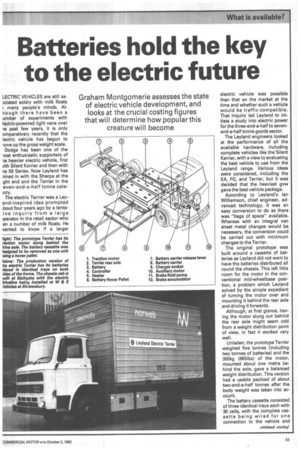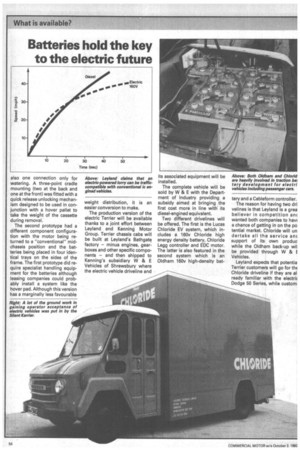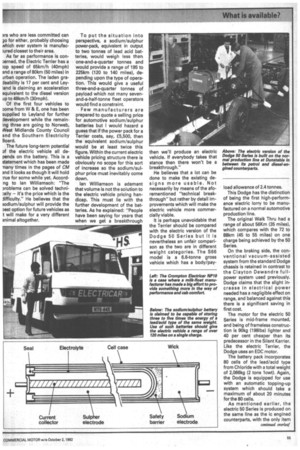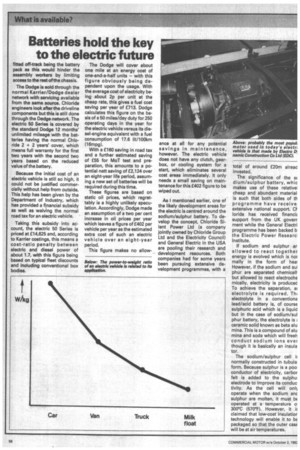Batteries hold the key to the electric future
Page 33

Page 34

Page 35

Page 36

If you've noticed an error in this article please click here to report it so we can fix it.
Graham Montgomerie assesses the state of electric vehicle development, and looks at the crucial costing figures that will determine how popular this creature will become
LECTRIC VEHICLES are still asociated solely with milk floats many people's minds. Alhough there have been a umber of experiments with lectric-powered light vans over le past few years, it is only omparatively recently that the lectric vehicle has begun to love up the gross weight scale. Dodge has been one of the lost enthusiastic supporters of le heavier electric vehicle, first 6oith Silent Karrier and then with le 50 Series. Now Leyland has )ined in with the Sherpa at the ght end and the Terrier in the even-and-a-half tonne cateiory.
The electric Terrier was a Leyand-inspired idea prompted I bout four years ago by a tentae inquiry from a large iperator in the retail sector who an a number of milk floats. He vented to know if a larger
electric vehicle was possible than that on the market at the time and whether such a vehicle would be traffic-compatible. That inquiry led Leyland to initiate a study into electric power for the three-and-a-half to sevenand-a-half tonne goods sector.
The Leyland engineers looked at the performance of all the available hardware, including complete vehicles like the'Silent Karrier, with a view to evaluating the best vehicle to use from the Leyland range. Various ideas were considered, including the EA, FG, and Terrier, but it was decided that the heaviest gvw gave the best vehicle package.
According to Leyland's Ian Williamson, chief engineer, advanced technology, it was an easy conversion to do as there was "bags of space" available. Whereas with an integral van sheet metal changes would be necessary, the conversion could be carried out with minimum changes to the Terrier.
The original prototype was built around a cassette of batteries as Leyland did not want to have the batteries distributed all round the chassis. This left little room for the motor in the conventional mid-wheelbase position, a problem which Leyland solved by the simple expedient of turning the motor over and mounting it behind the rear axle and driving it forwards.
Although, at first glance, having the motor slung out behind the rear axle might seem odd from a weight distribution point of view, in fact it worked very well.
Unladen, the prototype Terrier weighed five tonnes (including two tonnes of batteries) and the 300kg (665Ibs) of the motor, mounted about one metre behind the axle, gave a balanced weight distribution. This version had a usable payload of about two-and-a-half tonnes after the body weight was taken into account.
The battery cassette consisted of three identical trays each with 30 cells, with the complete cassette being wired for one connection to the vehicle and also one connection only for watering. A three-point cradle mounting {two at the back and one at the front) was fitted with a quick release unlocking mechanism designed to be used in conjunction with a hover pallet to take the weight of the cassette during removal.
The second prototype had a different component configuration with the motor being returned to a "conventional" midchassis position and the batteries being placed in four identical trays on the sides of the frame. The first prototype did require specialist handling equipment for the batteries although leasing companies could probably install a system like the hover pad. Although this version has a marginally less favourable weight distribution, it is an easier conversion to make.
The production version of the electric Terrier will be available thanks to a joint effort between Leyland and Kenning Motor Group. Terrier chassis cabs will be built at Leyland's Bathgate factory — minus engines, gearboxes and other specific components — and then shipped to Kenning's subsidiary W & E Vehicles of Shrewsbury where the electric vehicle driveline and its associated equipment will be installed.
The complete vehicle will be sold by W & E with the Department of Industry providing a subsidy aimed at bringing the first cost more in line with its diesel-engined equivalent.
Two different drivelines will be offered. The first is the Lucas Chloride EV system, which includes a 160v Chloride high energy density battery, Chloride Legg controller and EDC motor. The latter is also featured in the second system which is an Oldham 160v high-density bat tery and a Cableform controller.
The reason for having two dri velines is that Leyland is a grea believer in competition anc wanted both companies to havE a chance of getting in on the po tential market. Chloride will un dertake all the service anc support of its own produc while the Oldham back-up wil be provided through W & E Vehicles.
Leyland expects that potentia Terrier customers will go for thE Chloride driveline if they are al ready familiar with the electric Dodge 50 Series, while custom. ars who are less committed can go for either, probably choosing Nhich ever system is manufaclured closest to their area.
As far as performance is conaerned, the Electric Terrier has a lop speed of 65km/h (40mph) 3nd a range of 80km 150 miles) in urban operation. The laden gradeability is 17 per cent and Leyland is claiming an acceleration aquivalent to the diesel version up to 48km/h (30mph).
Of the first four vehicles to Come from W & E, one has been supplied to Leyland for further development while the remaining three are going to Norweb, Nest Midlands County Council and the Southern Electricity Board.
The future long-term potential Df the electric vehicle all depends on the battery. This is a statement which has been made -nany times in the pages of CM 3nd it looks as though it will hold :rue for some while yet. Accordng to Ian Williamsoh: "The roblems can be solved technially it's the price which is the difficulty." He believes that the 3odium/sulphur will provide the 3est option for future vehicles as t will make for a very different animal altogether.
To put the situation into perspective, a sodium/sulphur power-pack, equivalent in output to two tonnes of lead acid batteries, would weigh less than one-and-a-quarter tonnes and would provide a range of 195 to 225km 1120 to 140 miles), depending upon the type of operation. This would give a useful three-and-a-quarter tonnes of payload which not many sevenand-a-half-tonne fleet operators would find a constraint.
Few manufacturers are prepared to quote a selling price for automotive sodium/sulphur batteries but I would hazard a guess that if the power pack for a Terrier costs, say, £5,500, then the equivalent sodium/sulphur would be at least twice this figure. Within the current electric vehicle pricing structure there is obviously no scope for this sort of increase so the sodium/sulphur price must inevitably come down.
Ian Williamson is adamant that volume is not the solution to the electric vehicle pricing handicap. This must lie with the further development of the batteries. As he explained: "People have been saying for years that when we get a breakthrough then we'll produce an electric vehicle. If everybody takes that stance then there won't be a breakthrough."
He believes that a lot can be done to make the existing designs more usable. Not necessarily by means of the aforementioned "technical breakthrough" but rather by detail improvements which will make the electric vehicle more commercially viable.
It is perhaps unavoidable that the Terrier should be compared with the electric version of the Dodge 50 Series but it is nevertheless an unfair comparison as the two are in different weight categories. The S66 model is a 6,6-tonne gross vehicle which has a body/pay load allowance of 2.4 tonnes.
This Dodge has the distinction of being the first high-performance electric lorry to be manufactured on a normal automotive production line.
The original Walk Thru had a range of about 56Km (35 miles), which compares with the 72 to 88km (45 to 55 miles) on one charge being achieved by the 50 Series.
On the braking side, the conventional vacuum-assisted system from the standard Dodge chassis is retained in contrast to the Clayton Dewandre fullpower system used previously. Dodge claims that the slight increase in electrical power needed has a negligible effect on range, and balanced against this there is a significant saving in first cost.
The motor for the electric 50 Series is mid-frame mounted, and being of frameless construction is 90kg (198Ibs) lighter and 40 per cent cheaper than its predecessor in the Silent Karrier. Like the electric Terrier, the Dodge uses an EDC motor.
The battery pack incorporates 80 cells of the lead/acid type from Chloride with a total weight of 2,066kg (2 tons lcwt), Again, the Dodge is equipped for use with an automatic topping-up system which should take a maximum of about 20 minutes for the 80 cells.
As mentioned earlier, the electric 50 Series is produced on the same line as the ic engined counterparts, with the only item fitted off-track being the battery pack as this would hinder the assembly workers by limiting access to the rest of the chassis.
The Dodge is sold through the normal Karrier/Dodge dealer network with servicing available from the same source. Chloride engineers look after the driveline components but this is still done through the Dodge network. The electric 50 Series is covered by the standard Dodge 12 months' unlimited mileage with the batteries having the normal Chloride 2 + 2 years' cover, which means full warranty for the first two years with the second two years based on the reduced value of the battery.
Because the initial cost of an electric vehicle is still so high, it could not be justified commercially without help from outside. This help has been given by the Department of Industry, which has provided a financial subsidy as well as waiving the normal road tax for an electric vehicle.
Taking this subsidy into account, the electric 50 Series is priced at £14,625 and, according to Karrier costings, this means a cost-ratio penalty between electric and diesel power of about 1.7, with this figure being based on typical fleet discounts and including conventional box bodies. The Dodge will cover about one mile at an energy cost of one-and-a-half units — with this figure obviously being dependent upon the usage. With the average cost of electricity being about 2p per unit at the cheap rate, this gives a fuel cost saving per year of £713. Dodge calculates this figure on the basis of a 50 miles/day duty for 250 operating days in the year for the electric vehicle versus its diesel-engine equivalent with a fuel consumption of 17.6 lit/100km (16mpg).
With a £160 saving in road tax and a further estimated saving of £55 for MoT test and preparation, this amounts to a potential nett saving of £2,124 over an eight-year life period, assuming a new set of batteries will be required during this time.
These figures are based on static oil prices, which regrettably is a highly unlikely speculation. Accordingly, Dodge made an assumption of a two per cent increase in oil prices per year which leaves a figure of £402 per vehicle per year as the estimated extra cost of such an electric vehicle over an eight-year period.
This figure makes no allow ance at all for any potential savings in maintenance, however. The electric vehicle does not have any clutch, gearbox, or cooling system for a start, which eliminates several cost areas immediately. It only needs a small saving on maintenance for this £402 figure to be wiped out.
As I mentioned earlier, one of the likely development areas for the electric is centred around the sodium/sulphur battery. To develop the concept, Chloride Silent Power Ltd (a company jointly owned by Chloride Group Ltd and the Electricity Council) and General Electric in the USA are pooling their research and development resources. Both companies had for some years been pursuing extensive development programmes, with a total of around £20m alread invested.
The significance of the sc dium/sulphur battery, whic makes use of these relativel cheap and abundant material: is such that both sides of th programme have receive extensive national support. Ch bride has received financii support from the UK goverr ment while the General Electri programme has been backed b the Electric Power Researcl Institute.
If sodium and sulphur an allowed to react together energy is evolved which is nor malty in the form of heal However, if the sodium and sul phur are separated chemicall, but allowed to react electroche mically, electricity is produced To achieve the separation, al electrolyte is required. Thi electrolyte in a conventiona lead/acid battery is, of course sulphuric acid which is a liquid but in the case of sodium/sul phur battery, the electrolyte is ceramic solid known as beta alu mina. This is a compound of alu mina and soda which will freeh conduct sodium ions ever though it is basically an insula tor.
The sodium/sulphur cell normally constructed in tubule form. Because sulphur is a pool conductor of electricity, carbor felt is added to the sulphul electrode to improve its conduc, tivity. As the cell will onl) operate when the sodium anc sulphur are molten, it must bE operated at a temperature a 300°C (570°F). However, it if. claimed that low-cost insulatior technology will enable it to be packaged so that the outer case will be at air temperatures.












































